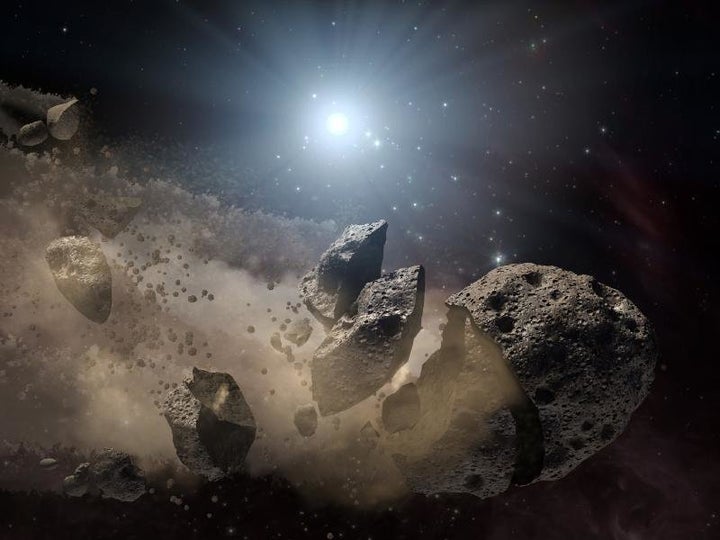
The theory of which asteroid was responsible for killing the dinosaurs 65 million years ago has been shattered to pieces -- literally.
New data from NASA's WISE (Wide-field Infrared Survey Explorer) satellite suggests that an asteroid from the Baptistina family was actually not -- as previously thought -- responsible for the mass extinction, NASA reported on Monday.
UPDATE BELOW
"As a result of the WISE science team's investigation, the demise of the dinosaurs remains in the cold case files," Lindley Johnson, program executive for the Near Earth Object (NEO) Observation Program at NASA, said in a statement.
The Baptistina theory was originally published in the journal Nature in 2007.
According to that theory, Baptistina crashed into another asteroid in the main belt between Mars and Jupiter about 160 million years ago. The collision sent shattered pieces as big as mountains flying. One of those pieces was believed to have impacted Earth, causing the dinosaurs' extinction.
Using the infrared-sensitive telescope on the WISE, scientists analyzed the sunlight reflected off of over 1,000 asteroids in the Baptistina family. They found that the Baptistina asteroid actually broke up 80 million years ago, not 160 million years ago as researchers had thought.
"This doesn't give the remnants from the collision very much time to move into a resonance spot, and get flung down to Earth 65 million years ago," said Amy Mainzer, a co-author of a new study appearing in the Astrophysical Journal and the principal investigator of NEOWISE at NASA's Jet Propulsion Laboratory (JPL) in Pasadena. Calif. "This process is thought to normally take many tens of millions of years." Resonances are areas in the main belt where gravity nudges from Jupiter and Saturn can act like a pinball machine to fling asteroids out of the main belt and into the region near Earth.
Scientists still believe that an asteroid hitting Earth 65 million years ago was responsible for the extinction of the dinosaurs, but now they're less sure of where exactly it came from.
"We are working on creating an asteroid family tree of sorts," Joseph Masiero, the lead author of the study said. "We are starting to refine our picture of how the asteroids in the main belt smashed together and mixed up."
NASA's WISE was launched in 2009 to map the entire sky. It is currently hibernating after mapping the sky twice, according to NASA.
Click here for some of the amazing images that the WISE spacecraft has sent back.
UPDATE: September 21, 2011 at 2:00 p.m. EDT
So what about the theory that the Baptistina asteroid was responsible for the extinction of the dinosaurs?
Bill Bottke, one of the lead authors of the paper, told HuffPost that despite what NASA said in its press release, scientists don’t yet know enough to rule out the Baptistina theory.
“I’d say our story is weakened, but I don’t know if they have enough to say that it’s fatal,” he said. “There’s some game left to be played.”
NASA said on Monday that since data from WISE spacecraft shows that the original Baptistina is younger than Bottke and his team had thought, it wouldn’t have had enough time -- only 15 million years -- to hit the Earth and cause extinction.
But Bottke, who’s the Assistant Director at the Department of Space Studies at the Southwest Research Institute and the Director of the Center for Lunar Origin and Evolution, takes issue with the idea that 15 million years isn’t enough time for a large piece from the Baptista asteroid to reach the Earth.
“I think that’s wrong,” he said. “No time is not the same as less time.”
Bottke, however, is very excited about the data from the WISE spacecraft, which hadn’t even been launched when his team published their Baptistina paper.
“It is an interesting result,” he said. “And I think it celebrates how cool this data is from the WISE spacecraft. We’re going to be doing a lot of science with this.”